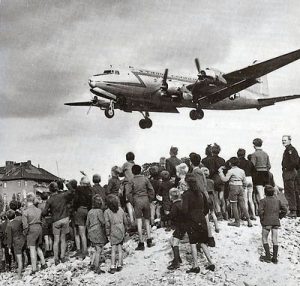
Seventy years ago, on May 12, 1949, the Berlin Blockade came to an end. Nowadays considered a cornerstone of the Cold War Era, the blockade had been initiated eleven months earlier by the Soviet military administration in response to the introduction of a new currency, the Deutsche Mark, in the American, British, and French occupation zones of Germany and the allied sectors of Berlin. The Soviets understood the D‑Mark as a prelude to the establishment of a single economic unit and a new government in West Germany. Thus, to prevent the distribution of the currency and to force the Western coalition to abandon the city, the Soviet military administration began blocking West Berlin, halting all rail, road and barge traffic as well as cutting off gas and electricity supplies.
The end of the Berlin Blockade represented a major victory over the Soviet military administration and, in particular, over Stalin who had underestimated how far the West was willing to go to retain control over the allied sectors of Berlin. Indeed, Berlin soon became a symbol of the allies’ determination to integrate the Western occupation zones and the allied sectors of the city into the post-World War II landscape of Western Europe and the North Atlantic region. President Harry S. Truman concluded:
“On May 12 the blockade of Berlin was lifted. The battle of diplomacy was overshadowed by the drama of the aerial convoys that day after day went their way into Berlin. The longer the blockade continued, the more the people of Germany looked toward the West to strengthen them in their determination to remain free. The city celebrated the event with an awareness of its solidarity with the democratic nations. Berlin became a symbol which made the ally determination greater and greater to do the job.”
Only two days after the blockade had been imposed, allied supply transports into Berlin via aircrafts began. The Berlin Airlift was born. From the start, the airlift constituted a truly concerted effort. Under the leadership of General Lucius D. Clay, a Combined Airlift Task Force was organized to counter the Soviet blockade. In the months to follow, allied aircrews from the United States Airforce, the Royal Air Force, and the French Air Force were joined by crews from Canada, Australia, New Zealand, and South Africa. Together these crews transported a total of 2.3 million tons of food, fuel, and other supplies to the more than two million people in Berlin.
Retrospectively, the success of the Airlift seems to obscure the precariousness of the scenario. In the summer of 1948, the allies were somewhat uncertain about their capacities to supply Berlin. Time was scarce. Berlin was expected to run out of food rations within 36 days, out of coal within 25 to 50 days, and out of diesel and gasoline within two to five months. Whether Tempelhof Airport and the Royal Air Force Station Gatow provided the means to maintain the airlift could hardly be predicted; and, although the CIA assumed that Moscow was not willing to risk military confrontation, the Soviets would undoubtedly attempt to hinder the Western powers in their efforts to fly food supplies, commodities, and fuel into the city. Soon after the Airlift started, Soviet airplanes were seen entering the corridors. Still, the abandonment of Berlin was never under consideration:
“The abandonment of Berlin would be interpreted throughout Germany and Europe as evidence of our lack of determination both to defend our rights and to support democratic peoples in their effort to resist totalitarian threats and pressures.” (Department of State, Office of Public Affairs, Information Memorandum No. 28, January 7, 1949)
The Berlin Airlift did not end with the lifting of the blockade, but continued until the fall of 1949. By then, the Western Allies had stocked the storehouses of the city with food, fuel, and other supplies essential for survival in order to prevent a future supply shortage. However, the Berlin Airlift did not only deliver cargo to a city cut off from the world, the airlift shaped and transformed the relationship between the Western Allies and the people of Berlin and West Germany. For years to come, the Berlin Airlift became a lieu de mémoire, a site of memory, that helped define the partnership between the people of the Federal Republic of Germany and the Western Allies, a partnership built on democratic values and friendship.
Berlin Airlift (Edited Footage) – “The Bridge,” produced by Department of Defense, Department of the Army, Office of the Chief Signal Officer, April 19, 1949. National Archives at College Park, National Archives Identifier: 21227, Local Identifier: 111-ADC-7455.
19,330 Total Views, 11 Views Today






